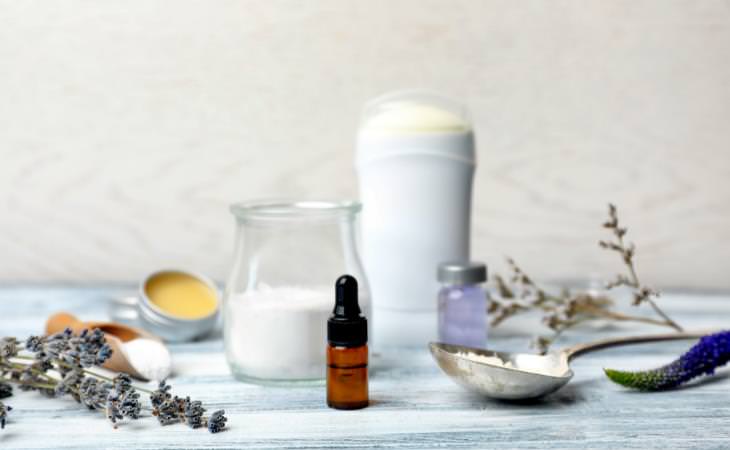Let's break down the two kinds of deodorants: there are antiperspirants, and there are plain deodorants. The former, as their name suggests, prevent you from perspiring. They do so by blocking your sweat glands and keeping your armpits dry. They can be fragrance-free, which is the best and least irritating form. The latter will not prevent you from sweating but will help with body odor simply by masking it with nice scents, allowing you to still sweat through.
The natural deodorizers in the following article will NOT prevent perspiration, but they will help fight body odor, and some can even be used in addition to your everyday deodorant for an extra boost, in case they don't last you the guaranteed 24-hours (Do they ever? Not in my experience).
Facial AHA Toners
If the previous passage seems like Chinese to you, allow us to translate.
What are toners? Toners are a skin treatment that is usually used for cosmetic benefits as part of a skincare routine. They have a runny liquid consistency and are used for many purposes: some are hydrating toners, some are exfoliating toners, some treat spots, and so on. You usually soak a generous amount on a cotton pad and spread it evenly across your face.
What are AHAs? Now we're getting to the deodorant part. Alpha Hydroxy Acids is a group of water-soluble exfoliating ingredients, naturally found in fruits. They break down the bonds in dead skin cells on your skin, helping to reveal a smoother, brighter surface. The two most researched AHAs are Glycolic acid and Lactic acid.
You can use a fragrance-free Lactic Acid toner or a Glycolic acid toner as a natural deodorant!
Simply soak a cotton ball in the toner, rub it on your armpits and let them dry. If you don't want to use a disposable cotton pad you can use reusables and wash them after every use or use your hands, but make sure to wash them!
Remember, this will not prevent you from sweating, but you can use it under your regular deodorant to further combat body odor. AHAs are essentially scentless on their own, so if you choose a fragrance-free toner, it won't overpower your perfume or cause any headaches.
A Little Chemistry
How does it all work? AHAs have a low pH profile. This means they both eliminate odor-causing bacteria that naturally live on our skin, and create an acidic environment that prevents that same bacteria from growing.
Now is a good place to address dosage: since these are acids, after all, a slight tingling sensation is possible. Make sure to choose a toner without fragrance to lower chances of irritation to the skin, and gradually build up your concentration, starting from 5% acid toners to no more than 10% for the armpits.
Additional benefits of using AHAs as deodorizers:
AHAs can treat rough dry skin and even pigmentation and discoloration! Our armpits can be darker than the rest of the body for many reasons: thick hair roots, thick dead skin layer due to repetitive scrubbing and hair removal, and even post-inflammatory hyperpigmentation.
Glycolic acid disperses melanin (pigment of our skin) and smooths out the surface of our skin.
Lactic acid is a better option for sensitive skin as it does not penetrate as deep into the skin, and it is also a powerful humectant, meaning it keeps moisture within the skin.
Tea Tree Essential Oil
The method of use with this essential oil is similar to how you would use AHA toners: you rub it on the skin as a natural deodorizer. As for using it under your antiperspirant, we recommend a small patch test as tea tree oil is a very potent substance that could easily irritate the skin. We would also suggest using a cotton round for this one, as tea tree oil has a very strong earthy aroma that's hard to get off your hands. You should only use it if you like the smell.
Tea tree oil is an immensely powerful natural antiseptic. It kills both bacteria and fungus that may live on your skin and cause body odor. It has innumerable other benefits and uses, some of which are listed here, so know that keeping a small bottle of it is always a good idea.
CAUTION: Do not ingest the oil under any circumstances. While it does have the word tea in the name, the oil is not derived from the same plants used to make traditional teas.
A Natural DIY Deodorant

We would advise sticking to store-bought toners or essential oils. These are professionally formulated by chemists to be applied to your skin. That being said, there are low-risk recipes for DIY deodorants containing ingredients that are beneficial in treating body odor, such as shea butter (a soothing moisturizer), baking soda (a known natural deodorizer), arrowroot or corn starch (moisture absorbing), and tea tree oil.
Here's a good stick deodorant recipe from Houseful of Handmade:
Ingredients:
- 3/4 oz beeswax
- 2 oz coconut oil
- 3/4 oz Shea butter
- 2 Tbsp baking soda
- 2 Tbsp cornstarch
- 1/4 cup arrowroot powder
- 10-20 drops tea tree oil (or other essential oil)
Instructions:
- Place beeswax, coconut oil, and Shea butter in a small saucepan with some water and simmer until the oils are completely melted.
- Remove from heat and stir in the baking soda, cornstarch, and arrowroot powder. Then stir in the tea tree oil.
- Pour into 2 empty stick deodorant containers.
- Allow to harden before use.
For further information about skincare ingredients, we recommend searching them in Healthline and INCIDecoder.




